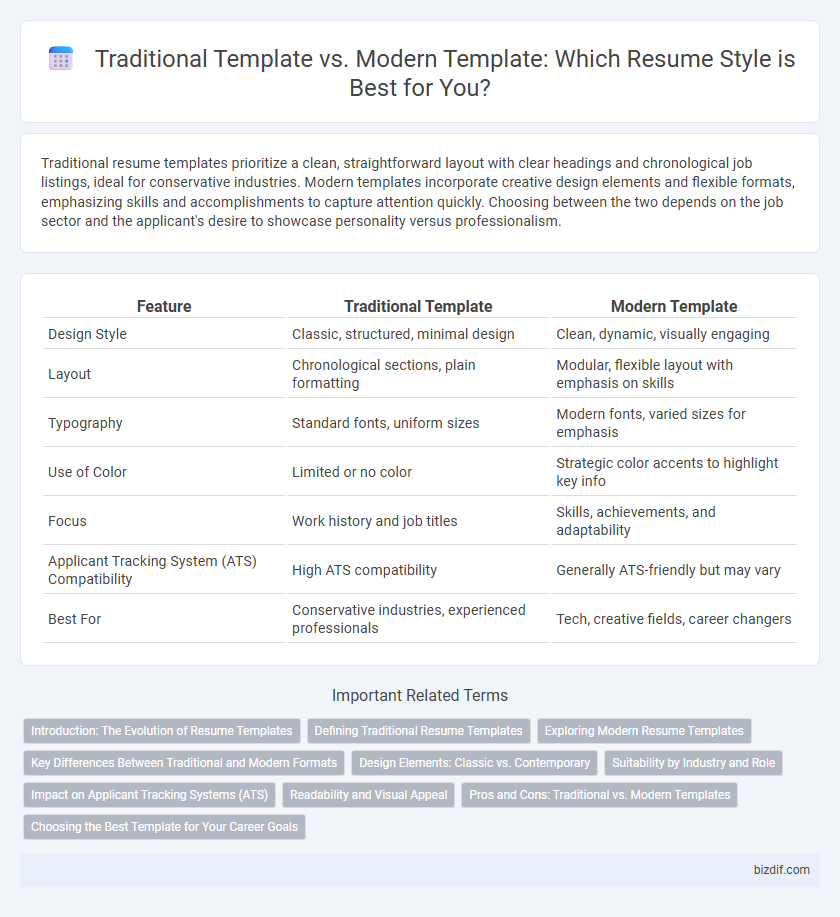Traditional resume templates prioritize a clean, straightforward layout with clear headings and chronological job listings, ideal for conservative industries. Modern templates incorporate creative design elements and flexible formats, emphasizing skills and accomplishments to capture attention quickly. Choosing between the two depends on the job sector and the applicant's desire to showcase personality versus professionalism.
Table of Comparison
| Feature | Traditional Template | Modern Template |
|---|---|---|
| Design Style | Classic, structured, minimal design | Clean, dynamic, visually engaging |
| Layout | Chronological sections, plain formatting | Modular, flexible layout with emphasis on skills |
| Typography | Standard fonts, uniform sizes | Modern fonts, varied sizes for emphasis |
| Use of Color | Limited or no color | Strategic color accents to highlight key info |
| Focus | Work history and job titles | Skills, achievements, and adaptability |
| Applicant Tracking System (ATS) Compatibility | High ATS compatibility | Generally ATS-friendly but may vary |
| Best For | Conservative industries, experienced professionals | Tech, creative fields, career changers |
Introduction: The Evolution of Resume Templates
Resume templates have evolved from traditional formats characterized by rigid structures and conservative designs to modern templates emphasizing creativity and ATS-friendly layouts. Traditional templates often prioritize chronological work history, suitable for conventional industries, while modern templates incorporate infographics and customizable sections tailored for digital recruitment tools. This shift reflects changing hiring practices, where clarity, visual appeal, and keyword optimization have become essential for candidate visibility.
Defining Traditional Resume Templates
Traditional resume templates emphasize a clean, structured layout with clear headings and chronological work experience, typically favoring classic fonts like Times New Roman. These templates highlight consistency and professionalism, prioritizing straightforward presentation of skills and achievements without excessive design elements. By focusing on simplicity and readability, traditional resumes appeal to conservative industries such as law, finance, and government sectors.
Exploring Modern Resume Templates
Modern resume templates emphasize clean lines, minimalistic design, and strategic use of white space to enhance readability and highlight key achievements. These templates often incorporate infographic elements and customizable sections tailored to specific industries, improving the applicant's visual storytelling. Compared to traditional templates, modern resumes increase the chances of passing Applicant Tracking Systems (ATS) and attracting recruiter attention through optimized keyword placement and dynamic layouts.
Key Differences Between Traditional and Modern Formats
Traditional resume templates emphasize a structured layout with clear section headings, prioritized chronological work history, and conservative fonts and formatting. Modern resume templates showcase creativity through minimalist design, use of color, icons, and infographic elements that highlight skills and accomplishments over dates. The key differences lie in traditional formats focusing on clarity and formality, while modern formats aim for visual appeal and immediate impact to catch recruiters' attention.
Design Elements: Classic vs. Contemporary
Traditional resume templates feature classic design elements such as serif fonts, clear section divisions, and conservative formatting that emphasize readability and professionalism. Modern templates incorporate contemporary design trends like minimalist layouts, sans-serif fonts, and bold color accents to capture attention and reflect creativity. Choosing between classic and contemporary designs depends on industry norms and personal branding goals to ensure the resume effectively communicates the candidate's qualifications.
Suitability by Industry and Role
Traditional resume templates are ideal for conservative industries such as finance, law, and government where clarity, professionalism, and a straightforward format are prioritized. Modern resume templates suit creative fields like marketing, design, and technology, offering innovative layouts and visual elements that highlight skills and personal branding. Selecting the appropriate template based on industry and role enhances the chances of passing applicant tracking systems and resonating with hiring managers.
Impact on Applicant Tracking Systems (ATS)
Traditional resume templates often rely on complex formatting and graphics that can confuse Applicant Tracking Systems (ATS), leading to parsing errors and reduced keyword recognition. Modern templates utilize clean layouts with simple fonts and standardized headings, improving ATS readability and increasing the likelihood of passing initial screenings. Adopting ATS-friendly formats significantly enhances a candidate's chances of being shortlisted by ensuring accurate extraction of relevant skills and experience.
Readability and Visual Appeal
Traditional resume templates emphasize a clean, structured format with clear headings and consistent font styles, enhancing readability for applicant tracking systems (ATS) and hiring managers. Modern templates incorporate creative design elements such as color accents, icons, and varied typography to capture attention while maintaining visual hierarchy. Balancing readability and visual appeal in resume design increases engagement and effectively communicates key skills and experiences.
Pros and Cons: Traditional vs. Modern Templates
Traditional resume templates offer a clean, structured layout favored by conservative industries and applicant tracking systems, ensuring clarity and easy scanning but may appear outdated to creative employers. Modern templates incorporate dynamic design elements and infographics that highlight skills and achievements visually, appealing to innovative sectors but risk compatibility issues with some automated screening tools. Balancing readability and creativity depends on the target industry, with traditional templates excelling in formality and modern templates enhancing personal branding impact.
Choosing the Best Template for Your Career Goals
Choosing the right resume template greatly influences how your skills and experience are perceived by recruiters in your industry. Traditional templates highlight professionalism with clear sections and conservative formatting, ideal for corporate or more formal roles, while modern templates utilize sleek designs, color accents, and innovative layouts to grab attention in creative fields. Aligning your resume template with your specific career goals ensures better visibility and improves your chances of landing interviews tailored to your target job market.
Traditional Template vs Modern Template Infographic

 bizdif.com
bizdif.com